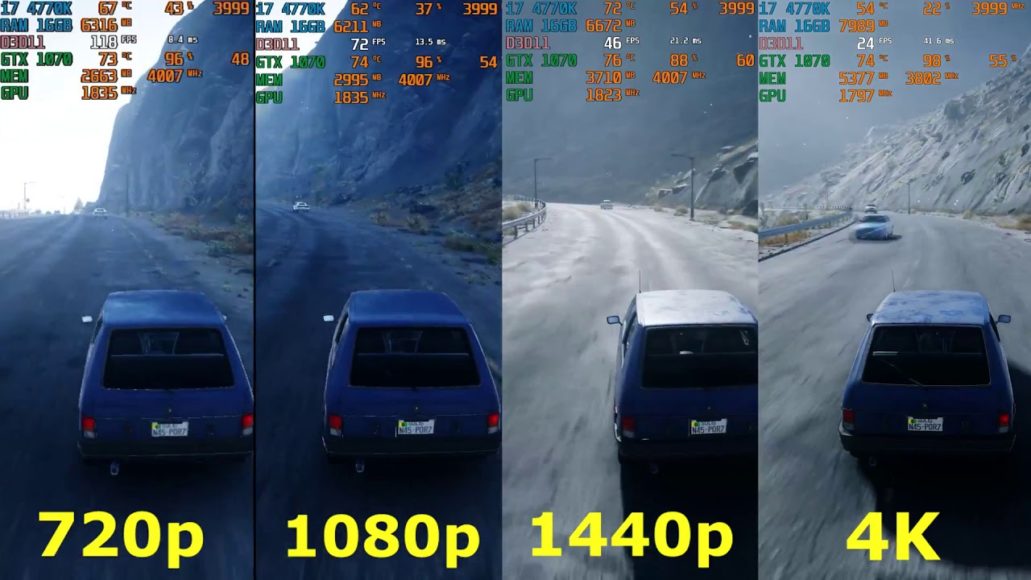What you need to know about 720p and 1080p. 720p and 1080p are both high definition video resolution formats, but that’s where the similarity ends. There are differences between the two that can affect the TV you buy and your TV viewing experience.
Page Contents:
This information applies to any modern television display; including but not limited to those produced by LG, Samsung, Panasonic, Sony, and Vizio.
Screen resolution- 1080p offers more lines
720p
- 720p is 1,280 pixels displayed horizontally on the screen and 720 pixels vertically on the screen. This produces 720 horizontal lines on the screen, which are, in turn, displayed progressively, or each line displayed in succession.
1080p
- 1080p is 1,920 pixels displayed on the screen horizontally and 1,080 pixels vertically on the screen. This results in 1,080 horizontal pixels on the screen, which are in turn displayed progressively or each row of pixels displayed in succession. In other words, just like with 720p, all rows (lines) of pixels are displayed progressively.
The number of pixels that make up a 720p image is about 1 million (equivalent to 1 megapixel in a digital camera), while there are 2 million pixels in a 1080p image. This means that a 1080p image can display many more details than a 720p image.
However, how does this translate into what you see on a TV screen? Shouldn’t it be easy to see the difference between a 720p and 1080p television? Not necessarily.
The pixel density at 720p and 1080p, the screen size and the sitting distance from the screen must be taken into account.
If you have a 720p or 1080p TV/video projector, the number of pixels displayed for each is the same, regardless of the screen size- the changes are the number of pixels per inch.
This means that when the screen gets bigger, the pixels get bigger so that the sitting distance affects the way you perceive the details displayed on the screen.
Common programming- 720p dominates the transmission
720p
- Municipality for television broadcasting – via cable and satellite.
- Most 720p TVs can automatically resize the content.
1080p
- Blu-ray discs use a resolution of 1080p (or 1080i).
- Modern smartphones can record 1080p videos.
TV stations and cable/satellite providers send the programming in different resolutions. Many use 720p, while most providers and most premium services, like HBO, use 1080i. Also, there are some cable and satellite feeds that are sent at 1080p and DirecTV offers 4K programming. Internet streaming providers send a variety of resolutions, including 720p, 1080p, and 4K.
For cable and satellite, a 720p TV will resize the 1080i and 1080p input signals based on its native pixel resolution (720p TVs are not compatible with 4K signals). If you access content through a multimedia streamer, you can set the output to match the TV resolution. If you have a smart TV, it will resize the incoming streaming signal to match the display resolution.
Contrary to what many people think, it is possible to use the Blu-ray Disc player with a 720p TV. All Blu-ray disc players can be set for 480p / 720p / 1080i / or 1080p output via HDMI output connection.
Also, when connected to a TV or video projector via HDMI, most Blu-ray Disc players will automatically detect the native resolution of the TV/projector and set the output resolution accordingly. Blu-ray Disc players also offer the option to manually set the output resolution.
The final verdict- let your eyes be your guide
720p
- Cheaper hardware and smaller screen sizes.
- Most 720p TVs can resize content to 1080p but are not compatible with 4K input signals.
- Ideal for people who only watch TV programs mostly.
1080p
- Better image quality.
- Overkill for TV broadcast only.
- Great for Blu-ray disc libraries.
720p TVs are available, but the selection is decreasing and is limited for smaller screens. It is rare to see a 720p TV larger than 32 inches. This is due to the increased availability and lower prices of 4K televisions, which resulted in a decreasing number of both 1080p and 720p sets.
Furthermore, most TVs labeled as 720p TVs actually have a native pixel resolution of 1366 × 768, which is technically 768p.
However, they are usually advertised as 720p TVs. Don’t be discouraged, these sets will accept all incoming 720p, 1080i and 1080p resolution signals. The TV will process and resize any incoming resolution up to 1080p to the native display resolution of 1366 × 768 pixels.
720p and 1080p TVs are both classified as HD TVs, but 1080p TVs are often labeled as FHD (Full HD) TVs.
This is intended to help consumers by pointing out that televisions with 1080p native resolution take full advantage of HD video resolution standards and will not be as much resembled by 1080i and 1080p content sources as they would be on a 720p television.
The way you perceive the difference between 720p, 1080p or any other resolution, is in the real viewing experience with your TV.
You may find that a specific 720p TV looks better than a specific 1080p TV because the resolution is only a factor. Motion response, color processing, contrast, brightness and upscaling or video downscaling also contribute to image quality.
The quality of the source signal also plays an important role. The video processor of a TV can only compensate for the poor quality signals of the source, in particular, VHS or analog cable, and, for Internet streaming sources, the quality depends not only on the source but on the speed of Internet streaming.

